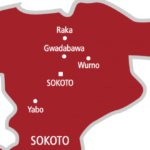Queen Amina of Zazzau held sway for thirty four years from 1536. She was the eldest daughter of the 22nd Habe Monarch, Queen Bakwa Turunku of Zazzau, who built and transferred the capital to the present town of Zaria in 1537 A.D. According to the Abuja Chronicle, in ‘Fakul Maisuri’ Sultan Bello, son of Sheikh Uthman Bin Fodio, wrote; “Strange things have happened in the history of the Hausa States, and the strangest of these is the extent of the possessions which God gave to Aminatu daughter to ruler of Zazzau. She waged wars in the Hausa lands and took them all, so that the men of Katsina and the men of Kano brought her tribute. She made war in Bauchi and against the other towns of the south and of the west, so that her possessions stretched down to the shores of the sea.”
Muhamman Makau, the 60th Habe King of Zazzau was overthrown on Saturday, the 10th day of Zul Hajj 1804, as a result of the Usman Danfodio Jihad. Rather than remaining in the Kingdom as an ordinary subject, he decided to migrate. Although his dethronement was bloodless, Makau’s exodus southwards took place under hot pursuit by his Fulani adversaries. He hadn’t the slightest idea that in a distant future his destination would be in the geographical center of a country Nigeria, which was yet to be found.
Among Makau’s entourage as he migrated were his title holders and loyalists, including two of his brothers Abubakar Jatau, popularly known as Abu-ja and Abu-kwaka, all sons of the 59th King of Zaria, Sarkin Zazzau Ishaku Jatau. Also, in their possessions were vital historical artifacts of the Zazzau Kingdom, including the great sword of Zazzau. They passed through Kauru and Kajuru, where they couldn’t stay, due to the hostilities at their trail. When they arrived at Zuba, the Koro Chief Muhamman Gwabo accorded Makau his due recognition as Sarkin Zazzau and opened for him the gate. But Makau chose to remain outside to fight his pursuers for one year three month, when he defeated and turned them back, before entering Zuba. Thereafter, all the Gwari and Koro tribe gave Makau allegiance as done whilst he was in Zaria.
Muhamman Makau later died in another battle field, after which his brother Abu-ja established the Abuja town in 1825 and brought the south western Zazzau under his effective control. According to the Abuja Chronicle the Fulani Emir of Zaria Mamman Sani came up against Abuja all the way from Zaria, but ended up making a truce with Abu-ja the king, when he discovered that although not controlled by the Fulanis, the Islamic religion is strong in the land. More so, Sheikh Bin Fodio also instructed, that should any of the conquered monarchs flee he should not be pursued.
Sarkin Zazzau Mamman Sani was vindicated, when the armistice was violated in 1893 by Sarki Yero, at that time Ibrahim Iyalai was the Sarkin Zazzau of Abuja. Out of instigation, Sarki Yero of Zaria waged war on Abuja, and he suffered heavy defeat, which led to his demise.
In his introduction to the Chronicle of Abuja Dr Frank Heath wrote “When the Fulani, in their holy war of conquest, drove the original Habe king of Zazzau from Zaria, he made himself a new kingdom out of these Abuja lands. Established here, he and his successors beat off every attempt of the Fulani (the last in 1893) to reduce their stronghold, one of the only three places left where the old Hausa customs survived almost unchanged. Bida fell, and most of the surrounding country was carved up into the principalities of Keffi, Nassarawa, Lapai, and last, Kontagora; indeed, control of nearly all Northern Nigeria passed into the hands of the Fulani – but never Abuja”.
Thus it was not for nothing that Makau and his followers chose this geographical area after passing so many lands and making so many to come under their control, perhaps it has to do with the inspiration the land exudes. Though, without the divine knowledge of the unseen, some special wisdom of the people of the past could not have been a sheer coincidence. Certainly, there were some elements of spiritual guidance.
In the later period during the colonial era Mr. Michael Cardew a colonial officer and renowned porter was given the task of choosing a site for a pottery center for the Northern Nigeria. After touring all parts of the north he wrote in his report submitted in April 1951 that “We decided ABUJA after all, in spite of not being on the railway, good and central for the Northern Nigeria”. He further states, “Abuja was the place for inspiration and that would make for good pots”
The original Abuja Town was renamed Suleja at the advent of the FCT, after Suleimanu Barau, the great grandson of Abuja and the 7th Emir of Abuja. Although, being on same location, the V-shape at the top of the FCT map was deliberately created in order to carve out the original Abuja Town, which has a Hausa Monarch, in order to achieve the ethnic neutrality of the FCT.

 Join Daily Trust WhatsApp Community For Quick Access To News and Happenings Around You.
Join Daily Trust WhatsApp Community For Quick Access To News and Happenings Around You.


